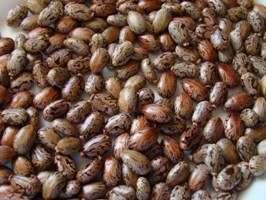Habitat
The castor bean is indigenous to Africa and India and has spread to all tropical and sub-tropical countries. Curious about plants that are native to the North America? Click here to learn about the American Raspberry. It is currently located in the United States in 28 states and in 2 colonies.
 warm season crop.
The plant is known to grow from 30 to 40 feet in tropical
climates and can become three to six inches around.
However, in temperate climates, such as North America,
they typically grow between three and eight feet.
A growing period of 140-190 days without frost is
required to obtain satisfactory yields.
It grows as a perennial plant in tropical and
sub-tropical climates and as an annual plant in temperate
climates.
warm season crop.
The plant is known to grow from 30 to 40 feet in tropical
climates and can become three to six inches around.
However, in temperate climates, such as North America,
they typically grow between three and eight feet.
A growing period of 140-190 days without frost is
required to obtain satisfactory yields.
It grows as a perennial plant in tropical and
sub-tropical climates and as an annual plant in temperate
climates.
In the United States the best location for these growing conditions are
southern Kansas, Missouri, Illinois, Indiana, Ohio, Kentucky, Tennessee,
Arkansas, Oklahoma and north Texas.
A lot of these regions also happen to be where a lot of the first
castor oil mills were opened.
Interested in learning about another plant harvested in the
United States? Go
here to learn about hops!
Missouri, Illinois, Indiana, Ohio, Kentucky, Tennessee,
Arkansas, Oklahoma and north Texas.
A lot of these regions also happen to be where a lot of the first
castor oil mills were opened.
Interested in learning about another plant harvested in the
United States? Go
here to learn about hops!
The map shown is probably an incomplete list knowing that almost every state has someone who grows the castor plant in their garden. This map shows where higher concentrations of castor plants are.
Still curious about the castor bean plant? Go on to Adaptation to learn more!
Back to Home To Multipleorganisms.net To UW-Lacrosse
